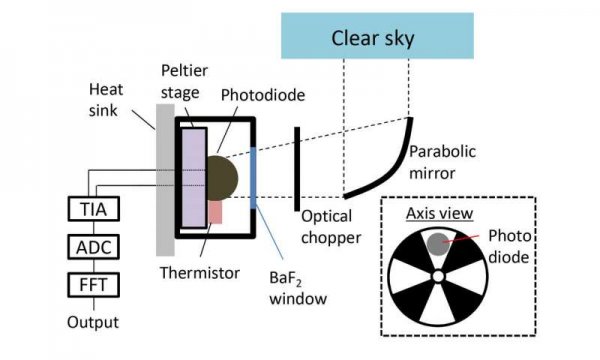
One disadvantage of solar panels is that they require sunlight to generate electricity. Some people have observed that for space-oriented devices on Earth, the energy cooled from the device can be collected using the optoelectronic physics principles we use to use solar energy. A new study published in "Applied Physics Letters" attempts to provide a potential way of generating electricity like solar cells, but this method can power electronic devices at night. This is a schematic diagram of an experimental infrared photodiode, which directly generates electrical energy from cold space. Source: Masashi Ono
Using an infrared photodiode pointing to the sky, a new device can extract energy from the temperature difference between the earth and the deep space near absolute zero.
The obvious disadvantage of solar panels is that they require sunlight to generate electricity. Some people have observed that for space-oriented devices on Earth, its temperature is very low, and the energy cooled from the device can be collected using the optoelectronic physics principles we use to use solar energy. AIP Press published a new work in the latest issue of Applied Physics Letters, which is expected to provide a method of generating electricity like solar cells, but this method can provide power to electronic devices at night.
A team of international scientists proved for the first time that it is possible to use the coldness of the universe to directly generate measurable electricity in a diode. Infrared semiconductor devices face the sky and use the temperature difference between the earth and space to generate electricity.
"The vastness of the universe is a thermodynamic resource," said the author Fan Shanhui. "In terms of optoelectronic physics, there is indeed a very beautiful symmetry between receiving incident radiation and receiving outgoing radiation."
In contrast to the energy used by ordinary solar cells, the negative light effect allows electrical energy to be collected when the heat leaves the surface. However, today's technology cannot capture the energy brought by these negative temperature differences as effectively as in the past.
By pointing their device to space with a temperature close to absolute zero, the research team discovered a temperature difference large enough to generate electricity through early design.
Masashi Ono, another author of the paper, said: "At present, the energy we can generate through this experiment is far below the theoretical limit."
The research team found that their negative lighting diodes can produce about 64 nanowatts per square meter. Although only a small amount of electricity is generated, this is an important proof of concept that the authors can improve the quantum optoelectronic performance of the materials they use. To improve this concept.
The diode electric display created after the calculation, when considering the influence of the atmosphere, the current equipment can almost theoretically produce 4 watts per square meter of equipment generated about one million times and is enough to help the required power machinery to run at night.
In contrast, today's solar panels produce 100 to 200 watts per square meter.
Although the research results show that the ground equipment can fly directly into the sky, Fan said that the same principle can also be used to recover the waste heat of the machine. Currently, he and his team are working to improve the performance of their equipment.
AWLOP CO.,LTD , https://www.awlop.com